 “Broadcasters are starting to understand VR pretty well, but are still looking to start-ups and VR industry to build the features”, Andre Lorenceau Founder and CEO at LiveLike VR told a packed room at VR & AR World in London today. “They would rather let us pioneer this sort of this stuff and then license it from us.”
“Broadcasters are starting to understand VR pretty well, but are still looking to start-ups and VR industry to build the features”, Andre Lorenceau Founder and CEO at LiveLike VR told a packed room at VR & AR World in London today. “They would rather let us pioneer this sort of this stuff and then license it from us.”
However, he stressed that broadcasters and live sports companies are investing in VR as chord-cutting begins to hit their audiences. “So they are switching to OTT and mobile, but this isn’t quite giving them the audience they need, so they are looking to VR,” Lorenceau said.
The difficulty with VR live spots is that they are expensive to create and offering just 360° viewing is not enough. At present, he said, there are only a handful of players in the VR sports space, including LiveLike. One of these is NextVR, which focuses on video “and being in the experience”. The other player Lorenceau cited was Voke, which also offers video, but also has some interests in hardware.
Also, bulk of equipment is important. “It needs to be usable on site,” he said.
He pointed out that with sports, you need to be interactive and social. He cited a company called Virtually Live, which works with Formula E on a VR recreation of the live race. “The experience is focused on the heavier tethered rigs, but they recreate the race,” he added, which allows users total immersion in the experience. He says that while this works well for Formula E, “for football, it loses some of the detail”.
“LiveLike is somewhat of a half-way house,” he explains. “We create lounge-like experiences. This allows us to shoot with cheaper rigs, but gives us a ton of interactivity.”
He also advised broadcasters to make sure any VR they offer works on mobile and tablet, so that they can reach bigger audiences.
He added: “You can then build a ton of stuff in VR, from social to gamification. Ultimately this is what broadcast needs right now. To get broadcasters to accept VR you have to offer end-to-end workflow and monetization opportunities, or the support in the industry isn’t going to be enough to support these experiences.”

 of video VR is an excellent concept, but not all of it works. You have to remember that it is not an extension of traditional TV and broadcast,” he warned. “We have to throw away 100 years of technique. VR is totally different.”
of video VR is an excellent concept, but not all of it works. You have to remember that it is not an extension of traditional TV and broadcast,” he warned. “We have to throw away 100 years of technique. VR is totally different.”